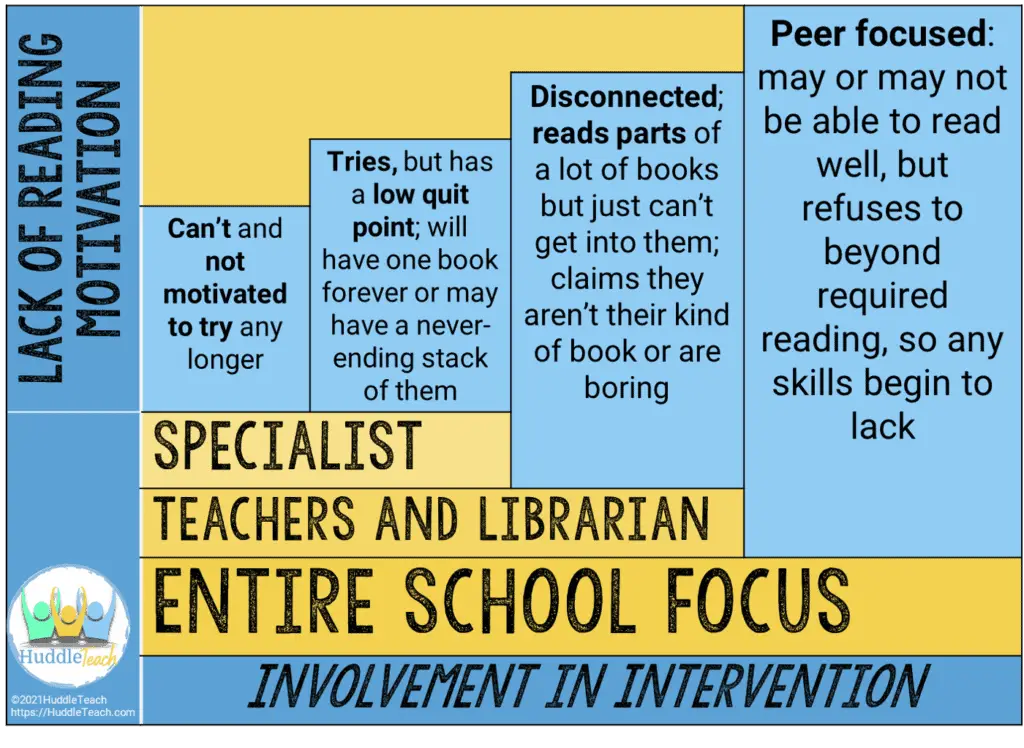
Facing the CAN’Ts and the WON’Ts
There are so many ways we say it:
She would be fine if she would just read…
I’m sure he can read, he just doesn’t want to…
We can’t make them read…
Kids just hate to read…
These would make more sense if we inserted the phrase “string beads” in place of “read” in the quotes above. After all, a child can live a full life without deep skills in stringing beads. Reading is different. Students who do not develop reading skills close doors to full participation in education, employment, and democracy. We often blame reading motivation as the underlying issue, but what if it isn’t?
130 Million People, 54% of adults, ages 16-74, lack proficiency in literacy, reading below the equivalent of a sixth-grade level.
Michael T. Nietzel, Forbes, Sep 9, 2020, access here
Early literacy programs limit the CAN’Ts before third grade, but there is a drop that occurs about fourth grade for far too many students.
Only 35 percent of fourth graders were proficient in reading in 2019, down from 37 percent in 2017; 34 percent of eighth graders were proficient in reading, down from 36 percent. Overall student progress in reading has stalled in the last decade, with the highest performers stagnating and the lowest-achieving students falling further behind.
By Erica L. Green and Dana Goldstein, The New York Times, Published Oct. 30, 2019Updated Dec. 5, 2019, accessed here.
And these numbers were from BEFORE the pandemic!
Middle Schoolers have an Un-Motivation Reputation
Arguably, no other grade levels scream YOU CAN’T MAKE ME louder than middle school. When we picture students who make peers and popularity more important than learning, we often see a middle school student. The transition from the supportive elementary and intermediate grades to the independence of high school is rough for a majority of students, no matter how conscientious the student was before middle school. Many parents are left wondering, What happened to my sweet, studious child?
So how and where do we begin, as middle school teachers, to close the gap for students before they become adults? How can we be sure there isn’t a CAN’T hiding beneath all that WON’T? First, we must study students who are struggling more closely before writing them off as apathetic or lazy. When students are not motivated to read, it often looks like this:
The Can’t and Won’t
This student most likely has a history of failing or covering for the lack of a skill that is overwhelming or exhausting. They often use negative self talk, aloud or silently, and avoid reading at all costs.
This student’s state assessment history probably includes at least one failed attempt, and grades may not all be above passing. This child may already have an issued a label, such as ADHD, 504 or SPED. It takes a skilled teacher or reading specialist to build a working relationship with this child, identify the probable cause for a reading deficit, and teach toward closing that gap, despite any label the child may carry.
The Trier
This student expends too much effort without enough return on that investment to continue reading a book. They often have a low quit point. While they may be cajoled into reading a book, these students use the word “boring” a lot. They may have a book checked out for weeks on end, or they may have a never ending stream of books they claim they have read.
Quit Points are responses to those situations when people cannot maintain their effort and experience a sudden decrease in focus and energy.
Quit Point by Adam Chamberlin and Svetoslav Matejic, 2018
Understanding each student’s quit point, or the point at which reading motivation ends, helps, but professionals like reading specialists and teachers must determine WHY reading is such hard work for the student. Comprehension is often the lacking skill, but the inability to solve longer words and phrases also affects this group. Teachers often offer texts that are low reading level / high interest (often called HIGH/LOW books) as a way to provide a quick return on the time investment of reading. These texts are usually short and have edgier subject matter.

The Disconnected
These students seem like they are reading but don’t expand on the book’s content when discussing. They may pile books up, making it look like they are consuming a lot of text, but in reality, they are reading very little of it. Their understanding is mostly literal and may be fabricated from a variety of sources, most often the movie that accompanies the book. These students have not connected on an emotional level with a book nor are they invested in its characters or subject matter.
A keen teacher or librarian conducts interest surveys and hosts reading conferences to recommend books that match a student’s interest. They also know which titles are sure winners with the middle school group, and will often choose one of those to suggest.
The Too-Cool
This peer-focused student does not want to identify as a reader if it is not considered cool. In the cut-throat social world of middle school, fitting in is the motivating factor. This situation may call for a cultural shift, making reading as cool as clubs and sports. This takes strong curricular leadership and broad commitment to literacy within all grades and subject matters.

So is it a reading motivation issue?
When students display a motivation issue, our first responsibility as reading teachers is to understand if there is an underlying reading issue in word solving, comprehension, vocabulary, and/or executive functioning. The tasks we ask students to complete should be presented in small chunks (rather than all assessments in a day), and must be presented in a way that elicits their best performance. These are some of my go-to assessments for determining if there is a CAN’T hiding behind the WON’T:

If deficiencies are shown through informal assessments, deeper digging, such as with the Quick Phonics Screener, can be completed. Once the knowledge threshold (the spot where skills begin to drop) is identified, intervention can begin!
But what if it IS a reading motivation issue?
In the case of The Disconnected and The Too-Cool, motivation is often the issue, so it takes librarians, teachers, and the broad school community to promote reading as a valuable exercise. Often, schools subscribe to programs that reward students’ reading, but this is a reaction that requires scrutiny and caution. There is ample research supporting the belief that few “rewards programs” actually have a long-term effect on motivation to read – and can actually reverse students’ internal motivation. Read more about ways to increase long-term motivation in an upcoming post!


